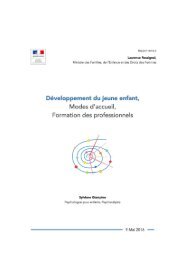agrl_innovations_in_ssa.pdf?utm_content=buffercb41d&utm_medium=social&utm_source=twitter
agrl_innovations_in_ssa.pdf?utm_content=buffercb41d&utm_medium=social&utm_source=twitter
agrl_innovations_in_ssa.pdf?utm_content=buffercb41d&utm_medium=social&utm_source=twitter
Create successful ePaper yourself
Turn your PDF publications into a flip-book with our unique Google optimized e-Paper software.
creat<strong>in</strong>g completely new ones. Such engagement is a nece<strong>ssa</strong>ry and consultative process<br />
that can be time-consum<strong>in</strong>g. It requires the creation of trust between stakeholders, a<br />
will<strong>in</strong>gness to work together, rais<strong>in</strong>g awareness of the challenges faced and the creation of<br />
a common vision for the future. Jo<strong>in</strong>t activities help to build ownership and accountability<br />
between partners.<br />
• Facilitat<strong>in</strong>g or broker<strong>in</strong>g these networks and alliances is a critical role <strong>in</strong> enabl<strong>in</strong>g<br />
<strong>in</strong>novation and <strong>in</strong>curs an <strong>in</strong>dispensable cost that is often overlooked. Unfortunately the<br />
competencies required for this role are scarce and <strong>in</strong> many case <strong>in</strong>vestors are unwill<strong>in</strong>g to<br />
fund this crucial role. The market rarely pays for this and support by public funds is often<br />
required as a catalyst.<br />
• The case studies demonstrated different forms of facilitation. Some were <strong>in</strong>itiated by<br />
farmer organisations, others by private companies or NGOs, with most be<strong>in</strong>g <strong>in</strong>itiated by<br />
m<strong>in</strong>istries of agriculture or research <strong>in</strong>stitutions. This does however <strong>in</strong>dicate that it is not<br />
the type of organisation that is important, but rather the need for facilitation and capacity<br />
build<strong>in</strong>g to create effective alliances.<br />
• Facilitation or broker<strong>in</strong>g needs ‘champions’, either <strong>in</strong>dividuals or <strong>in</strong>stitutions, who<br />
understand the often-complex <strong>in</strong>stitutional and regulatory structures, <strong>in</strong> which alliances<br />
need to be encouraged. This requires <strong>in</strong>dividuals with the experience and skills to<br />
coord<strong>in</strong>ate networks of actors from public and private sectors.<br />
• IPs represent a strong approach to empower<strong>in</strong>g participat<strong>in</strong>g stakeholders, build<strong>in</strong>g<br />
capacities and identify<strong>in</strong>g opportunities able to analyse and alleviate constra<strong>in</strong>ts or add<br />
value with<strong>in</strong> a systems cha<strong>in</strong>. However the IP itself needs to be dynamic and evolve so that<br />
it becomes stronger and <strong>in</strong>creas<strong>in</strong>gly relevant.<br />
Creat<strong>in</strong>g strong farmer organisations<br />
• Strong farmer organisations at all levels have a critical role to play <strong>in</strong> <strong>in</strong>creas<strong>in</strong>g smallholder<br />
productivity and livelihoods, improv<strong>in</strong>g competitiveness and <strong>in</strong>creas<strong>in</strong>g barga<strong>in</strong><strong>in</strong>g power<br />
for markets, services and enhanc<strong>in</strong>g the policy environment. It is essential that farmer<br />
organisations are able to speak with an <strong>in</strong>formed and unified voice and are able to engage<br />
with other stakeholders. At the same time they must be representative and able to<br />
communicate with members and other farmers.<br />
Involv<strong>in</strong>g the private sector and ensur<strong>in</strong>g market-driven approaches<br />
• Market constra<strong>in</strong>ts are successfully dealt with through better understand<strong>in</strong>g and<br />
<strong>in</strong>formation about demand and supply, market price and its determ<strong>in</strong>ants, and <strong>in</strong> particular<br />
market l<strong>in</strong>kages. As such the private agribus<strong>in</strong>ess sector needs to be <strong>in</strong>volved not only <strong>in</strong><br />
the supply of <strong>in</strong>puts and purchas<strong>in</strong>g outputs but also <strong>in</strong> develop<strong>in</strong>g market opportunity<br />
and capacity-build<strong>in</strong>g <strong>in</strong>itiatives.<br />
• Understand<strong>in</strong>g the positive role the private agribus<strong>in</strong>ess sector can play <strong>in</strong> facilitat<strong>in</strong>g<br />
change at local and national levels is important when consider<strong>in</strong>g changes to the enabl<strong>in</strong>g<br />
environment. The private sector also needs to be well organised and able to speak with an<br />
<strong>in</strong>formed and unified voice <strong>in</strong> engag<strong>in</strong>g with the public sector.<br />
102 Agricultural Innovation <strong>in</strong> Sub-Saharan Africa






